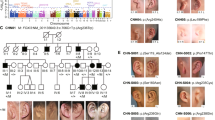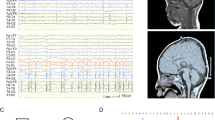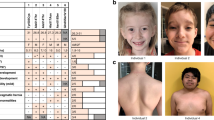Abstract
Molecular bases of the clinically heterogenous Oculo-Auriculo-Vertebral Spectrum or Craniofacial Microsomia remain largely unknown. Although genetic diagnosis is established in less than 10% of the patients, variants in the FOXI3 gene are the most recurrent genetic cause. We studied a large family with 6 affected individuals on 4 generations showing an autosomal dominant transmission of Oculo-Auriculo-Vertebral Spectrum with incomplete penetrance. The genome sequencing strategy allowed the identification of a new likely pathogenic missense variant located within the Nuclear Localization Signal of FOXI3 and affecting its subcellular localization. Moreover, we described 3 additional rare FOXI3 variants identified in 3 other patients from a cohort of 251 patients with Oculo-Auriculo-Vertebral Spectrum. These variants were classified as Variants of Unknown Significance. In conclusion, this study confirms FOXI3 implication in the Oculo-Auriculo-Vertebral Spectrum and the importance of Nuclear Localization Signal integrity. Genotype-phenotype correlations and putative modifier haplotype are discussed.
This is a preview of subscription content, access via your institution
Access options
Subscribe to this journal
Receive 12 print issues and online access
$259.00 per year
only $21.58 per issue
Buy this article
- Purchase on SpringerLink
- Instant access to full article PDF
Prices may be subject to local taxes which are calculated during checkout

Similar content being viewed by others
Data availability
The data that support the findings of this study are available from the corresponding author upon request.
References
Barisic I, Odak L, Loane M, Garne E, Wellesley D, Calzolari E, et al. Prevalence, prenatal diagnosis and clinical features of oculo-auriculo-vertebral spectrum: a registry-based study in Europe. Eur J Hum Genet. 2014;22:1026–33.
Tingaud-Sequeira A, Trimouille A, Sagardoy T, Lacombe D, Rooryck C. Oculo-auriculo-vertebral spectrum: new genes and literature review on a complex disease. J Med Genet. 2022;59:417–27.
Tassano E, Jagannathan V, Drögemüller C, Leoni M, Hytönen MK, Severino M, et al. Congenital aural atresia associated with agenesis of internal carotid artery in a girl with a FOXI3 deletion. Am J Med Genet A. 2015;167:537–44. Mar 1
Quiat D, Timberlake AT, Curran JJ, Cunningham ML, McDonough B, Artunduaga MA, et al. Damaging variants in FOXI3 cause microtia and craniofacial microsomia. Genet Med. 2023;25:143–50.
Mao K, Borel C, Ansar M, Jolly A, Makrythanasis P, Froehlich C, et al. FOXI3 pathogenic variants cause one form of craniofacial microsomia. Nat Commun. 2023;14:1–16.
Berenguer M, Tingaud-Sequeira A, Colovati M, Melaragno MI, Bragagnolo S, Perez ABA, et al. A novel de novo mutation in MYT1, the unique OAVS gene identified so far. Eur J Hum Genet. 2017;25:1083–6.
Singh S, Jangid RK, Crowder A, Groves AK. Foxi3 transcription factor activity is mediated by a C-terminal transactivation domain and regulated by the protein phosphatase 2A (PP2A) complex. Sci Rep. 2018;1:17249.
Acknowledgements
The authors warmly thank the patients and their families. They thank the clinical geneticists for providing patients and Andrew Groves for providing plasmids for transactivation luciferase assay.
Funding
This project was supported by “La Fondation Maladies Rares” (project #12844-Genomics), “l’Académie Nationale de Médecine”and “l’Association Française d’ORL Pédiatrique”-Fondation Audika 2022.
Author information
Authors and Affiliations
Contributions
AS planned, performed experiments, analyzed data and co-wrote the manuscript; BL analyzed data; TS, ES, DL and AT clinically ascertained patients and provided samples; CR supervised, planned experiments, co-wrote and edited the manuscript.
Corresponding author
Ethics declarations
Competing interests
The authors declare no competing interests.
Ethics approval and consent to participate
The local ethics committee (Comité de Protection des Personnes: DC2012/76) approved this study. Informed consent was obtained from the patients and/or their parents in the case of minors before genetic analysis was performed. Authorization for publication, including the publication of photographs, was obtained for patients 1.IV.4 and 2.II.3.
Additional information
Publisher’s note Springer Nature remains neutral with regard to jurisdictional claims in published maps and institutional affiliations.
Rights and permissions
Springer Nature or its licensor (e.g. a society or other partner) holds exclusive rights to this article under a publishing agreement with the author(s) or other rightsholder(s); author self-archiving of the accepted manuscript version of this article is solely governed by the terms of such publishing agreement and applicable law.
About this article
Cite this article
Sequeira, A., Sagardoy, T., Bourgeade, L. et al. Novel variants in FOXI3 gene confirm its implication in Oculo-Auriculo-Vertebral spectrum. Eur J Hum Genet 33, 683–687 (2025). https://doi.org/10.1038/s41431-025-01837-6
Received:
Revised:
Accepted:
Published:
Issue date:
DOI: https://doi.org/10.1038/s41431-025-01837-6



